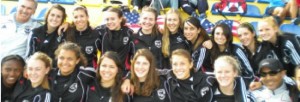No, they are not on ESPN yet. They are not making the front page of the sports section. But mark my words, within five years, they will be.
Four weeks ago, I traveled internationally to play soccer and represent my country. As a member of the Region IV Olympic Development Program (ODP), I went to Algarve, Portugal to spend a week like a professional soccer player. No school, no family, no homey comforts. Just me, my team and my favorite sport.
With the hype of playing the Irish National team and participating in international athletics, you might think that it would have been all business. Get there, play, go to bed, eat, play, leave. But, on the contrary, the girls from Region IV taught me to love soccer in a new way.
I now present to you the future of women’s soccer… collegiate signees, national team members, girls with guns the size of Davante Adams’s (’11) and players that change the game. Don’t believe me? I’ll prove it.
1. Megan Kufeld (’11) – Fremont, Calif. Commitment status: University of Washington. Position: Goalkeeper. Quiet and reserved like an animal, she waits for her prey to show weakness before she obliterates them. Her only kryptonite: AP Bio. Yet, despite her beef with organisms, Megan was the team tutor, teaching us everything from how to calculate Fahrenheit from Celsius to how to say “We just beat you” in Portuguese.

2. Maya Theuer (’12) – San Diego, Calif. Commitment Status: None. She is just a sophomore. Position: Center defender. She commands the back in a way that only a military general can. She could pick up Kevin Anderson (’11) if you asked her to, no sweat. And before she goes to sleep every night she does 90 push-ups and 100 sit-ups.
3. Lo’eau Labonta (’11) – Los Angeles, Calif. Commitment Status: none as of yet. Captain of the squad and moral leader of the team. Small, feisty and virtually indestructible. She knows all the words to Mulan and can auto-tune like my boy T-pain.
As a rookie in the ODP circuit, I had much to learn. But by traveling abroad with these seasoned veterans I became a pro in no time. Let me be the first to tell you the hints inside U.S. soccer….
First, you must take losing bags with style. No tears, no complaints, just wear that dirty underwear with swag. Don’t worry, the luggage will come back to you on the last day.
Second, no matter how gross the food is, eat it. Nothing says I don’t want to be here like refusing the double fried cod with roasted tofu artichoke pasta and chocolate curd.
Third, bring nutella and peanut butter: you can literally put them on anything (including artichoke pasta).
Fourth, no matter how much jet lag you have, don’t force your roommate to stay awake while you are watching Glee on your ipod under the covers (thanks Megan).
Fifth, even if the Internet costs 26 Euros for 24 hours (about 35 dollars), buy it.
But I digress. This ODP program, contrary to that of men’s soccer, is the leading example of women’s soccer at the highest level. For years, boys all over the world have had youth national teams. At ages three and four, they are given cleats and told to hit the field. But in the soccer world, the U.S. men’s ODP program is laughed at – the U.S. was learning how to pass while the other countries were perfecting the bicycle kick. On the contrary, girls in the U.S. benefit from being part of the greatest training organization in the world.
What I never realized is that the sport of soccer is much larger than just the extent to which it is played here. No men in short shorts crying over a slide tackle. In Spain and Portugal, soccer is life.



